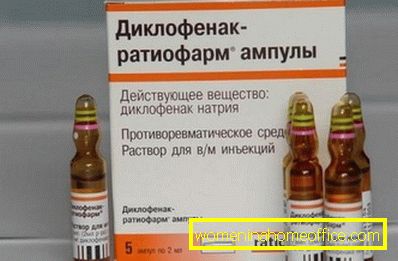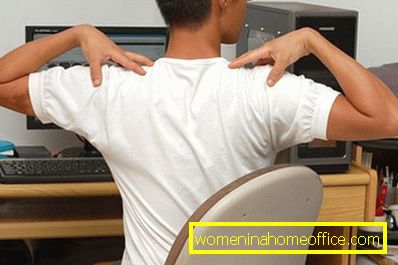Symptoms and treatment of cervical osteochondrosis in women
The spine worries many. But, instead of helping him, we make new mistakes: we move a little, we sit incorrectly. As a result, it crunches there, it hurts, the legs and arms go numb, the neck does not turn, but it’s dizzy. Familiar symptoms? It means that it will be useful for you to learn how the treatment of cervical osteochondrosis is carried out in women.
Why does the disease develop and what does it lead to?

Today, up to 80% of adults have spinal problems. Most often the cervical region suffers. It is the most mobile, the vertebrae here are not too strong, which is why they are so susceptible to insidious ailment. In this area, the arteries that feed the brain are located very close to the spinal column.
The structure of the spine is somewhat reminiscent of bone beads. The vertebrae are interspersed with cartilaginous intervertebral discs. They play the role of softening pads. If the load on the vertebra is distributed incorrectly, the discs are compressed, the vertebrae "roll". The body is doing everything to make the structure stable, so the connective bone begins to grow. Thickening, the vertebral processes exert pressure on the vessels. The blood flow is weakened, the brain lacks oxygen, there is dizziness and headache.
What will happen if you ignore the treatment of cervical osteochondrosis? In women, this disease can lead to disruption of metabolic processes, cause hypoxia of internal organs. Without proper therapy, mental and physical abilities weaken, forgetfulness appears, speech control is lost, the vestibular apparatus suffers. Ultimately, it becomes difficult for a person to self-maintain, and everything can end in disability.
One of the root causes of this disease is menopause. With the development of cervical osteochondrosis, the body also responds to hormonal failure, injuries, hypothermia, obesity, infectious and other diseases.
Symptoms of cervical osteochondrosis

Signs of cervical osteochondrosis in women is very important to know. After all, treatment should be timely: only then can the pathological process be stopped and prevent the acquisition of a severe form of the ailment.
To help yourself or loved ones, remember the symptoms that cause such a disease:
- pain in the neck, crown and temporal part of the head;
- dizziness;
- blurred vision;
- noise in ears;
- feeling of lack of oxygen;
- drops of blood pressure (sometimes so strong that a person loses consciousness);
- muscle spasms and strain (because of this, there is a night snoring, hoarseness).
One of the most severe manifestations in cervical osteochondrosis is vertebral artery syndrome. Treatment will require long-term medication, exercise therapy, a complete lifestyle adjustment, and even surgery. Signs of this syndrome: constant or paroxysmal intense headache (aggravated by turning the head), hearing loss, severe dizziness, loss of vision and sight before the eyes, short-term loss of consciousness, impaired skin sensitivity, lump in the throat and cough.
What examination will be prescribed to the patient?
If a woman is worried about the above symptoms (or at least some of them), then she should contact a neurologist or therapist. The diagnosis will be made on the basis of such a diagnosis:
- evaluation of patient complaints;
- Ultrasound of brain and neck vessels;
- x-ray of the spine;
- MRI (detailed images of bones and soft tissues).
How is medical treatment carried out?

Cervical osteochondrosis must be treated comprehensively. Used medication, physiotherapy effects, used methods of manual therapy, gymnastics. Such drugs may be prescribed:
- if a woman complains of severe dizziness in case of cervical osteochondrosis, the treatment will include means to improve cerebral circulation, - Cavinton; Vinpocetine;
- with occasional dizziness - betahistine;
- NSAIDs - Indomethacin, Diclofenac;
- chondroprotectors - Glucosamine, Chondroitin sulfate, Hyaluronic acid;
- vitamin preparations and drugs that have a positive effect on metabolism - B-complex, nicotinic acid;
- antidepressants, sedatives - valerian, motherwort;
- with unbearable pains, the patient is being given a blockade (lidocaine, novocaine is injected).
The treatment will take at least 3 months or more. Physiotherapy is required. It helps to deliver the medicine directly to the affected area, which helps to overcome the ailment as soon as possible and without side effects. Osteopaths and chiropractors rule the back well.
Help in the form of folk remedies
If osteochondrosis got to the neck, it is helpful to recall simple ways of healing. Try these recipes:
- wraps from horseradish leaves (they can be replaced with burdock leaves). They are boiled over with boiling water, laid out on film and made a compress;
- warming honey ointment (150 g), ½ tbsp. vodka, 5 tbsp. l aloe. Compress put on 8-9 hours;
- a compress from cabbage and honey. Iron the cabbage leaf, brush with honey. Wear such a "collar" before going to bed or put on the night;
- anesthetic and warming agent, which includes cologne (100 ml), ½ bubble of iodine, a bottle of valerian alcohol tincture and 5 crushed tablets of dipyrone. All mixed, potion insist in a dark place in a dark container for 5 days. Rub their neck and wrap it with a scarf.
Inside you can take infusions and decoctions of nettle, lingonberry, birch buds and bear ears.
Fizkultminutka spine: exercises for the treatment of cervical osteochondrosis

During periods of remission, it is helpful to do such a gymnastics:
- smooth turns and tilts of the head to the sides and back and forth (5-10 times);
- pulling the neck back (goose stance);
- sitting, put your hand on your forehead and tilt your head, offering resistance (10 seconds);
- lifting shoulders.
If you periodically "wedge" your back, then you should not rub the neck with horseradish to the point of insanity: this way you will only get a burn. Osteochondrosis requires professional treatment. Let the doctor take care of your back - then the disease will stop, and the exacerbations will stop worrying. Do not be lazy to do gymnastics, go to the pool - this will increase the chances of a favorable outcome of treatment.